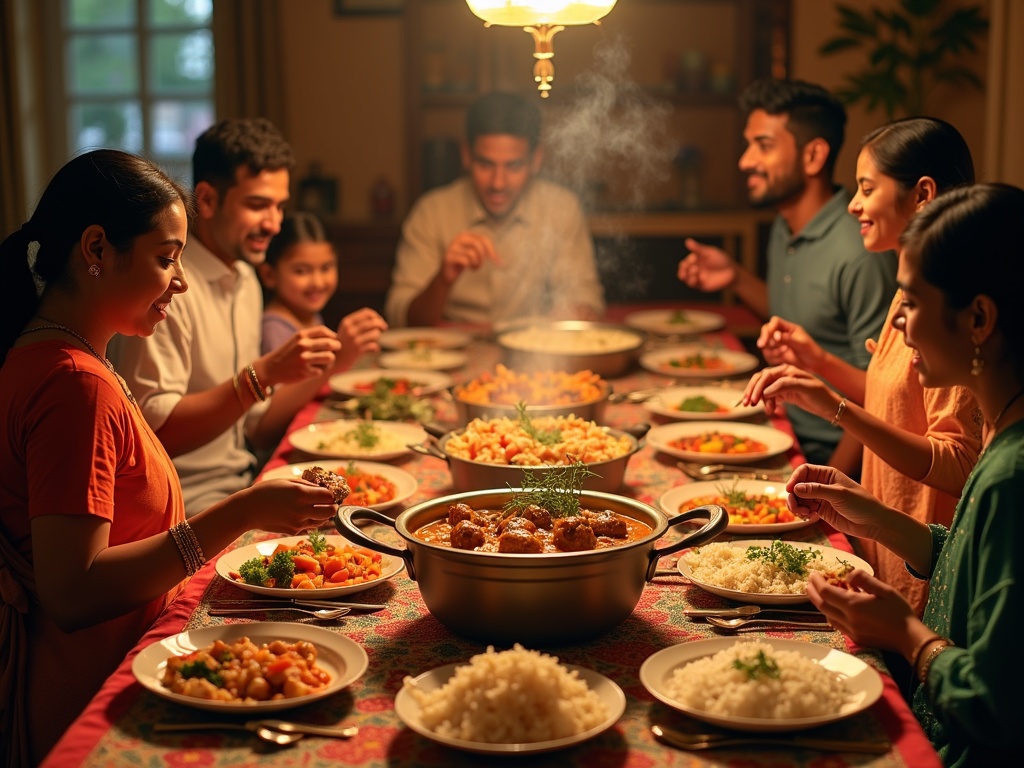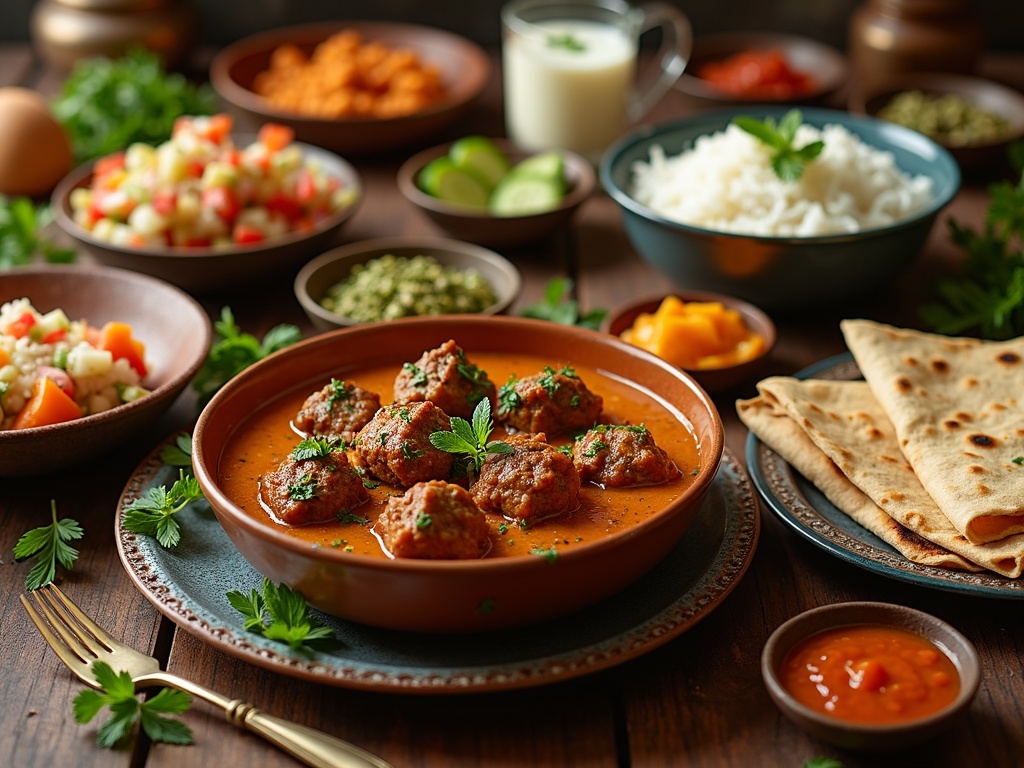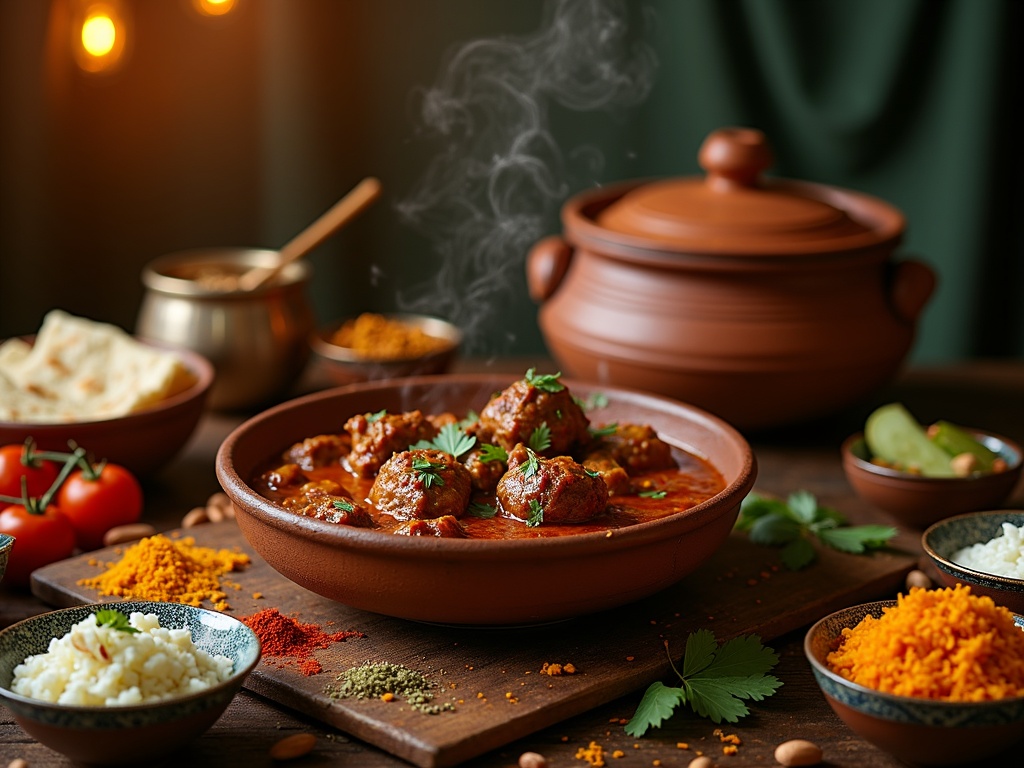Traditional lamb curry combines intricate spice blends with tender meat to create a cornerstone dish of South Asian cuisine that has captured taste buds across generations. The rich flavor profile stems from both culinary technique and cultural significance, with Indian spices holding an impressive 33% of the global spice market.
Find In This Article
Key Takeaways
- Traditional lamb curry preparation begins with marinating meat in yogurt, which tenderizes the lamb while adding tanginess and creating a protective moisture-retaining coating.
- The dish features regional variations across South Asia, with North Indian versions using garam masala, South Indian preparations incorporating coconut milk, Pakistani styles including potatoes, and Bangladeshi versions featuring mustard oil.
- The foundation of flavor comes from spices like cumin, coriander, turmeric, cardamom, cloves, and cinnamon, which offer both complex taste and digestive benefits.
- Lamb provides substantial nutritional value with 25 grams of protein per 100 grams, making it excellent for muscle maintenance when combined with vegetables.
- Proper cooking techniques like slow simmering for 1-3 hours and correctly blooming spices are essential for developing the dish’s characteristic depth of flavor.
The Art of Creating Traditional Lamb Curry
I’ve found that mastering a traditional lamb curry is like unlocking a culinary treasure. This iconic dish stands as a cornerstone in Indian, Pakistani, and Bangladeshi cuisine, bringing together rich flavors that have captivated taste buds across generations. The spice combinations aren’t just flavorful—they’re steeped in cultural significance, with Indian cuisine commanding an impressive 33% of the global spice market.
The Foundation of Flavor
Traditional lamb curry preparation is an exercise in patience and precision. The process typically begins with marinating chunks of lamb in yogurt, which tenderizes the meat while adding a subtle tanginess. The yogurt creates a protective coating that keeps the lamb moist during the slow-cooking process, resulting in meat that practically melts in your mouth.
The spice blend is where the magic happens. I start with a base of cumin, coriander, and turmeric, then layer in cardamom, cloves, and cinnamon for complexity. Each spice serves a purpose beyond flavor—many offer digestive benefits that complement the richness of the lamb. The slow-cooking method allows these spices to infuse fully into the meat, creating a depth of flavor that can’t be rushed.
Regional Variations and Nutritional Benefits
Lamb curry takes on different personalities depending on the region:
- North Indian versions often feature garam masala and a tomato-based gravy
- South Indian preparations might incorporate coconut milk and curry leaves
- Pakistani styles tend to use more whole spices and often include potatoes
- Bangladeshi versions frequently feature mustard oil and green chilies
Beyond its incredible taste, lamb provides substantial nutritional benefits, offering 25 grams of protein per 100 grams. This makes it an excellent choice for building and maintaining muscle. I’ve found that combining lamb with vegetable curry components creates a balanced meal that’s both satisfying and nutritious.
The key to an authentic lamb curry lies in honoring tradition while making small adjustments to suit your taste. Whether you prefer the rich flavors of a classic roast lamb or the complex spice profile of a curry, this dish demonstrates the beautiful marriage of technique and tradition that makes South Asian cuisine so beloved worldwide.
Essential Ingredients and Their Impact
The foundation of a memorable lamb curry starts with selecting quality ingredients. I’ve found that investing time in choosing the right components elevates this dish from ordinary to extraordinary.
Primary Components
The heart of any lamb curry begins with 1 kg of lamb, preferably from the shoulder or leg. These cuts offer the perfect balance of meat and fat, ensuring your curry develops deep flavor while remaining tender. Three medium onions provide essential sweetness and body to the gravy, while two ripe tomatoes contribute necessary acidity to balance the richness of the meat.
Garlic is non-negotiable – five cloves minced finely will infuse the dish with unmistakable depth. The combination of these base ingredients creates the foundation upon which the spices build their magic.
The core spice blend includes cumin, coriander, turmeric, and garam masala. Each plays a distinct role in developing the complex flavor profile that makes vegetable curry and meat curries so distinctive. Cumin provides earthy warmth, coriander adds citrusy notes, turmeric brings color and subtle bitterness, while garam masala rounds everything with aromatic complexity.
I always recommend using fresh spices rather than pre-ground varieties whenever possible. According to McCormick research, whole spices retain their volatile oils significantly longer than ground versions. Brands like McCormick and Spicebox offer high-quality options, but grinding your own delivers unmatched aromatic intensity.
Tenderizing Agents
Yogurt serves as more than just a flavor enhancer in lamb curry – it’s a crucial tenderizing agent. The natural acids and enzymes in yogurt break down tough muscle fibers in the lamb, resulting in meat that falls apart with gentle pressure from your fork. This tenderizing effect is particularly important when preparing roast lamb or curry dishes.
I typically use about 1 cup of plain, full-fat yogurt for 1 kg of meat. The fat content in the yogurt also helps carry flavors while adding a pleasant creaminess to the final dish.
The quality of each ingredient directly impacts your curry’s final flavor intensity. Premium lamb with good marbling provides more flavor than leaner cuts. Similarly, fresh aromatic spices create more vibrant results than those that have been sitting in your pantry for months.
When these quality ingredients come together through proper technique, they create a lamb curry that’s fragrant, complex, and deeply satisfying.
Mastering the Cooking Process
The secret to a truly spectacular lamb curry lies in patience and technique. I’ve found that the magic begins long before the heat turns on – it starts with proper marination.
Marination: The Foundation of Flavor
For an exceptional lamb curry, I always marinate the meat for a minimum of 2 hours, though overnight delivers the most remarkable results. This extended bath in yogurt and spices serves multiple purposes: the natural acids in yogurt tenderize the meat by breaking down tough muscle fibers, while simultaneously allowing the spices to penetrate deeply.
My basic marination mixture includes:
- Plain yogurt (Greek yogurt works well too)
- Minced garlic and ginger
- Ground spices (cumin, coriander, turmeric, garam masala)
- Salt
- A splash of lemon juice
The yogurt creates a protective coating that keeps the lamb moist during cooking, while the spices infuse throughout the meat. For the best results, I place the marinated meat in a covered container in the refrigerator, occasionally turning it to ensure even flavor distribution.
Cooking Methods and Timing
The cooking process itself demands equal attention. Traditional lamb curry requires slow cooking for 1-3 hours depending on the cut of meat and desired tenderness. This slow simmer allows the meat to become fork-tender while the flavors meld and intensify.
I often cook lamb curry in a traditional clay pot (handi) when possible. These earthenware vessels distribute heat evenly and impart a subtle earthy flavor that modern cookware simply can’t replicate. The porous nature of clay also allows slight evaporation, naturally concentrating the curry’s flavors.
That said, modern appliances offer convenience without significantly compromising quality:
- Dutch ovens provide excellent heat retention and distribution
- Slow cookers work wonderfully for hands-off cooking (4-6 hours on low)
- Instant Pots reduce cooking time dramatically while maintaining tenderness
For busy weeknights, I sometimes use a pressure cooker, which can transform tough lamb cuts into tender morsels in about 30 minutes. While slightly less developed in flavor than slow-cooked versions, the difference is minimal when you’ve properly marinated the meat beforehand.
When preparing vegetable curry additions to accompany the lamb, I add them at appropriate intervals to prevent overcooking – typically in the final 20-30 minutes of cooking.
The most critical technique in any curry preparation is properly blooming the spices. I always start by heating oil or ghee, then adding whole spices (cumin seeds, cardamom pods, cinnamon sticks) until fragrant before introducing ground spices. This step, which takes just 30-60 seconds, releases the volatile oils in the spices, activating their full flavor potential.
The blooming process requires close attention – burned spices will ruin your curry with bitter notes. I keep the heat medium-low and stir constantly during this phase. Once the spices are fragrant but not burned, I quickly add onions or other vegetables to stop the cooking process and prevent scorching.
The final simmering stage allows the lamb to become tender while absorbing the complex flavors you’ve developed. I check occasionally, adjusting liquid levels and seasoning as needed. The result should be meat that yields easily to a fork, swimming in a richly flavored sauce that’s neither too thin nor too thick.
During cooking, I resist the urge to constantly stir, which can break down the meat too much. Instead, I gently shake the pot occasionally to prevent sticking. When done, I let the curry rest for at least 15 minutes before serving, allowing the flavors to settle and intensify.
Health and Nutritional Benefits
I’ve discovered that lamb curry isn’t just a delicious meal—it’s packed with impressive nutritional benefits. When prepared with the right balance of spices and ingredients, this dish becomes a powerhouse of essential nutrients that support overall health.
Protein and Mineral Powerhouse
Lamb meat forms the foundation of any good lamb curry dish, providing exceptional nutritional value. A 100g serving of lamb delivers approximately 25% of your daily iron requirement—crucial for oxygen transport in the blood and preventing anemia. This makes it particularly beneficial for those with iron deficiencies or increased needs, such as pregnant women and athletes.
Beyond iron, lamb is rich in essential amino acids—the building blocks of protein that your body cannot produce on its own. These amino acids play vital roles in muscle repair, immune function, and hormone production. Lamb also contains significant amounts of vitamin B12, which supports nerve function and DNA synthesis.
When comparing nutritional profiles, lamb often outperforms other meat options in several categories:
- Higher zinc content for immune support
- More selenium for antioxidant protection
- Better quality protein with a complete amino acid profile
- Natural source of conjugated linoleic acid (CLA)
Spice Benefits Beyond Flavor
The magic of lamb curry extends beyond the meat itself to the aromatic spices that transform it into a complete dish. Traditional curry spices offer remarkable health benefits that complement the nutritional profile of lamb.
Turmeric, a signature curry ingredient, contains curcumin—a compound with potent anti-inflammatory properties. Regular consumption may help reduce chronic inflammation, which is associated with numerous health conditions. Similarly, garlic adds not just flavor but also provides antibacterial properties and may support heart health through improved blood pressure regulation.
Other common curry spices like ginger, cinnamon, and cardamom contribute additional health benefits:
- Ginger aids digestion and reduces nausea
- Cinnamon helps regulate blood sugar
- Cardamom contains compounds that may help fight infections
When combined with vegetables in a vegetable curry variation, the nutritional profile expands even further with added fiber, vitamins, and plant compounds.
The synergistic effect of these spices working together creates a meal that does more than satisfy hunger—it actively supports disease prevention. Research suggests that compounds found in curry spices may help reduce the risk of certain chronic conditions through their antioxidant and anti-inflammatory mechanisms.
For those looking to maximize the health benefits of lamb dishes, traditional roast lamb methods can be adapted to incorporate more of these beneficial spices. By marinating lamb in yogurt with turmeric, garlic, and ginger before cooking, you’ll not only enhance flavor but also increase the nutritional value of your meal.
I’ve found that adding leafy greens like spinach or kale to lamb curry near the end of cooking preserves their nutritional integrity while boosting the overall vitamin content of the dish. This simple addition turns an already nutritious meal into an even more complete source of essential nutrients.
When prepared thoughtfully, lamb curry represents an optimal balance of protein, essential nutrients, and beneficial plant compounds—making it not just a culinary delight but a genuinely nutritious choice for those seeking flavorful meals with substantial health benefits.
Cultural Impact and Modern Consumption
Lamb curry holds a special place in celebrations across South Asia, particularly during wedding feasts where it often serves as the centerpiece dish. The rich, aromatic lamb curry preparation symbolizes abundance and hospitality, making it an essential offering for honored guests. In many communities, the preparation becomes a communal activity with family members gathering to prepare the feast together.
Celebrations and Family Traditions
The significance of lamb curry extends far beyond just being a meal. According to 2020 data, approximately 75% of Indian households consume this dish at least once monthly, highlighting its enduring popularity. Family gatherings rarely feel complete without a steaming pot of fragrant lamb curry at the table, where traditions are passed down through generations.
Traditional communal dining practices enhance the cultural importance of this dish. In many South Asian homes, lamb curry is served in a central dish from which everyone partakes, reinforcing bonds of family and friendship. This shared experience creates lasting memories and strengthens community ties.
Regional variations in lamb curry preparation reflect local customs and available ingredients:
- Northern regions often feature yogurt-based curries with dried fruits and nuts
- Coastal areas incorporate coconut milk and seafood influences
- Eastern preparations might include mustard oil and panch phoron spice blends
- Western variations frequently use more dried spices and less liquid
These regional differences tell a story of cultural adaptation and local ingenuity. While the base remains lamb and spices, each community has developed its signature style that reflects its unique heritage and available resources.
I’ve found that modern consumption patterns have evolved as well. Many busy families have adapted traditional recipes to fit contemporary lifestyles, with pressure cookers and slow cookers becoming popular tools for preparing this time-honored dish. The vegetable curry combinations that accompany lamb dishes have also evolved, with more emphasis on seasonal and nutritious options to create balanced meals.
Despite these modern adaptations, the cultural significance of lamb curry remains undiminished, providing a delicious link to heritage and tradition that continues to bring people together across generations.

Perfect Pairings and Serving Suggestions
I’ve found that serving the perfect lamb curry is only half the battle—what you pair it with can transform your dining experience from good to extraordinary. The right accompaniments balance the rich, complex flavors of the curry and create a complete, satisfying meal.
Traditional Accompaniments and Modern Twists
Basmati rice stands as the quintessential partner for lamb curry. Its fragrant, fluffy texture acts as the perfect canvas for soaking up the flavorful sauce. I always take time to rinse the rice thoroughly before cooking to remove excess starch, resulting in perfectly separated grains that complement rather than compete with the curry.
Bread options offer another traditional route. Fresh, warm naan bread serves as both utensil and accompaniment, its slight chewiness and char marks from the tandoor adding texture contrast. Parathas, with their flaky, buttery layers, provide a richer alternative that stands up beautifully to the robust flavors of vegetable curry and meat dishes alike.
For a cooling contrast that’s essential with spicier curry variations, cucumber raita deserves a place at your table. This yogurt-based side dish cools the palate between bites of curry, creating a pleasant temperature and flavor balance. The refreshing combination of yogurt, cucumber, mint, and a touch of cumin provides relief from heat while adding another dimension to your meal.
Beverage pairings can elevate your curry experience further. For non-alcoholic options, lassi (a yogurt-based drink) provides cooling refreshment, while chai tea‘s warming spices can complement similar notes in the curry. If you’re including alcoholic beverages, light-bodied red wines like Pinot Noir pair surprisingly well with lamb curry, their bright acidity and fruit notes cutting through the richness of the meat.
The balance of flavors remains crucial when crafting a complete curry meal. I’ve learned that offering a variety of textures and temperatures creates the most satisfying experience. Consider these additional side dishes to enhance your lamb curry:
- Kachumber salad: A simple, fresh mix of diced cucumber, tomatoes, onions and lemon juice
- Pickled vegetables: Their tangy bite cuts through rich curry beautifully
- Chutney selection: Sweet mango, spicy mint, or tangy tamarind varieties offer different complementary notes
- Simple sautéed greens: Spinach or kale lightly spiced with cumin provides a nutritious counterpoint
For a more substantial feast, consider including a roast lamb as an additional protein option alongside your curry. The contrasting cooking methods highlight lamb’s versatility and create an impressive spread for guests.
When hosting, I like creating a table setting that allows guests to customize their plates. Family-style serving encourages sharing and conversation while allowing everyone to build their perfect curry experience. Small bowls filled with various chutneys, raita, and pickles add color to the table and flavor options for guests.
The presentation matters too—serving curry in warmed bowls helps maintain temperature throughout the meal, while separate serving dishes for rice and accompaniments prevent flavors from blending prematurely. Garnishing with fresh herbs like cilantro or mint adds a final fresh note and visual appeal.
By thoughtfully pairing your lamb curry with these complementary elements, you transform a single dish into a complete, balanced meal that delights all the senses.

Sources:
The History of Indian Spices
Nutritional Content of Lamb and Other Meat Types
Cultural Significance of Food in India
Spice Consumption: A Market Report
Health Benefits of Common Spices

